Related Research Articles
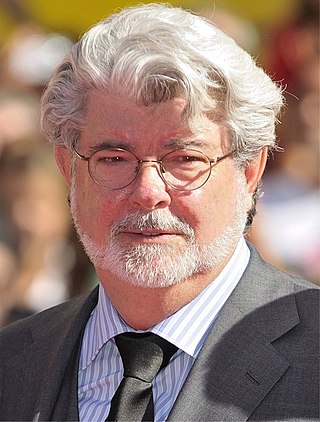
George Walton Lucas Jr. is an American filmmaker. Lucas is best known for creating the Star Wars and Indiana Jones franchises and founding Lucasfilm, LucasArts, Industrial Light & Magic, and THX. He served as chairman of Lucasfilm before selling it to The Walt Disney Company in 2012. Lucas is one of history's most financially successful filmmakers and has been nominated for four Academy Awards. Lucas personally directed or conceived 10 of the 100 highest-grossing movies at the North American box office, adjusted for ticket-price inflation. Lucas is considered to be one of the most significant figures of the 20th-century New Hollywood movement, and a pioneer of the modern blockbuster. Despite this, he has remained an independent filmmaker away from Hollywood for most of his career.
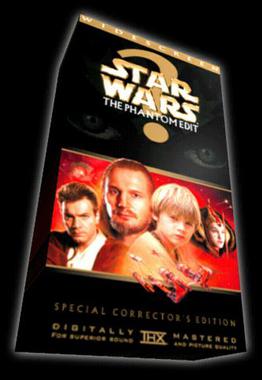
Star Wars Episode I.I: The Phantom Edit is a fan edit of the film Star Wars: Episode I – The Phantom Menace, removing many elements of the original film. The purpose of the edit, according to creator Mike J. Nichols, was to make a much stronger version of The Phantom Menace based on the previous execution and philosophies of film storytelling and editing of George Lucas. The Phantom Edit was the first unauthorized re-edit of The Phantom Menace to receive major publicity and acclaim and is also considered the first fan-edit of a feature film ever to be shared by an online audience.
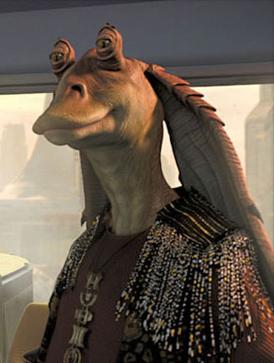
Jar Jar Binks is a fictional character of the Gungan race from the Star Wars saga created by George Lucas. Jar Jar appears throughout the Star Wars prequel trilogy – as a major character in Episode I: The Phantom Menace, with a smaller role in Episode II: Attack of the Clones, and with only a one-line cameo in Episode III: Revenge of the Sith – as well as having a role in the television series Star Wars: The Clone Wars. The first fully computer-generated supporting character in a live-action film, he has been voiced by Ahmed Best in most of his appearances, who also acted out the character with prosthetics prior to the CGI work. The last mention of Binks is in the 2017 canonical novel Aftermath: Empire's End.
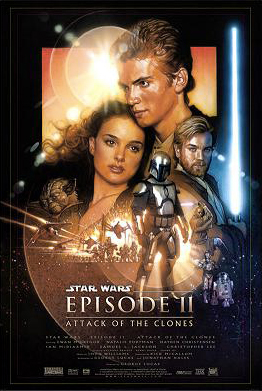
Star Wars: Episode II – Attack of the Clones is a 2002 American epic space opera film directed by George Lucas and written by Lucas and Jonathan Hales. The sequel to The Phantom Menace (1999), it is the fifth film in the Star Wars film series and second chronological chapter of the "Skywalker Saga". The film stars Ewan McGregor, Natalie Portman, Hayden Christensen, Ian McDiarmid, Samuel L. Jackson, Christopher Lee, Anthony Daniels, Kenny Baker, Frank Oz, Temuera Morrison, Silas Carson, and Jimmy Smits.
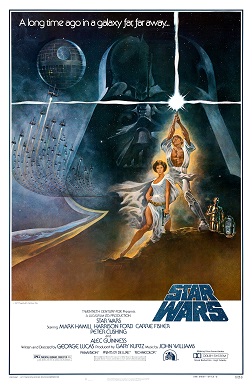
Star Wars is a 1977 American epic space opera film written and directed by George Lucas, produced by Lucasfilm and distributed by 20th Century-Fox. It was the first film released in the Star Wars film series and the fourth chronological chapter of the "Skywalker Saga". Set "a long time ago" in a fictional universe where the galaxy is ruled by the tyrannical Galactic Empire, the story focuses on a group of freedom fighters known as the Rebel Alliance, who aim to destroy the Empire's newest weapon, the Death Star. When Rebel leader Princess Leia is apprehended by the Empire, Luke Skywalker acquires stolen architectural plans of the Death Star and sets out to rescue her while learning the ways of a metaphysical power known as "the Force" from Jedi Master Obi-Wan Kenobi. The cast includes Mark Hamill, Harrison Ford, Carrie Fisher, Peter Cushing, Alec Guinness, David Prowse, James Earl Jones, Anthony Daniels, Kenny Baker, and Peter Mayhew.

Star Wars: Episode III – Revenge of the Sith is a 2005 American epic space opera film written and directed by George Lucas. It stars Ewan McGregor, Natalie Portman, Hayden Christensen, Ian McDiarmid, Samuel L. Jackson, Christopher Lee, Anthony Daniels, Kenny Baker, and Frank Oz. The sequel to The Phantom Menace (1999) and Attack of the Clones (2002), it is the sixth film in the Star Wars film series, the final installment in the Star Wars prequel trilogy, and third chronological chapter of the "Skywalker Saga".

Tatooine is a fictional desert planet that appears in the Star Wars franchise. It is a beige-colored, desolate world orbiting a pair of binary stars, and inhabited by human settlers and a variety of other life forms. The planet was first seen in the original 1977 film Star Wars, and has to date featured in a total of six Star Wars theatrical films, three live-action television series, and two animated series.

In the Star Wars space opera franchise, a droid is a fictional robot possessing some degree of artificial intelligence. The term is a clipped form of "android", a word originally reserved for robots designed to look and act like a human. The word "android" itself stems from the New Latin word "androīdēs", meaning "manlike", itself from the Ancient Greek ἀνδρος (andrós) + -ειδής (-eidḗs), itself from εἶδος.

Changes in Star Wars re-releases vary from minor differences in color timing, audio mixing, and take choices to major insertions of new visual effects, additions of characters and dialogue, scene expansions, and replacement of original cast members with newer ones. Though changes were also made to the prequel trilogy, the original trilogy saw the most alteration. Dissatisfied with the original theatrical cuts of the original Star Wars film, The Empire Strikes Back, and Return of the Jedi, creator George Lucas altered the films in ways that were ostensibly not initially possible, primarily due to limitations of time, budget, and technology.
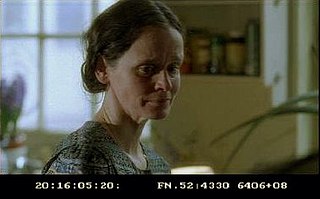
A workprint is a rough version of a motion picture, used by the film editor(s) during the editing process. Such copies generally contain original recorded sound that will later be re-dubbed, stock footage as placeholders for missing shots or special effects, and animation tests for in-production animated shots or sequences.
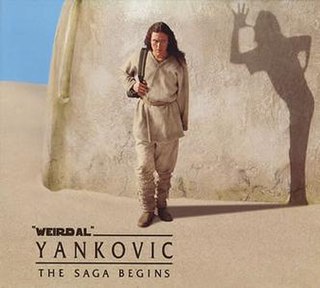
"The Saga Begins" is a parody song by "Weird Al" Yankovic. It parodies "American Pie" by Don McLean, with lyrics that humorously summarize the plot of the film Star Wars: Episode I – The Phantom Menace through the point of view of Obi-Wan Kenobi, one of the film's protagonists.
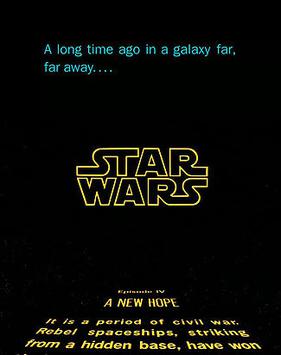
The Star Wars opening crawl is a signature device of the opening sequences of every numbered film of the Star Wars series, an American epic space opera franchise created by George Lucas. Within a black sky background featuring a smattering of stars, the crawl is preceded both by the opening static blue text, "A long time ago in a galaxy far, far away...." and by the Star Wars logo which recedes toward a central point on the screen before disappearing. The crawl text, which describes the backstory and context of the film, then recedes toward a higher point in relation to the screen and with an apparent effect of disappearing in the distance. The visuals are accompanied by the "Main Title Theme", composed by John Williams.

Raising Cain is a 1992 American psychological horror thriller film written and directed by Brian De Palma, and starring John Lithgow, Lolita Davidovich and Steven Bauer.

Star Wars Celebration is a large fan convention held to celebrate the Star Wars franchise. The event is usually held annually in varying locations around the world, and commonly features a host of Star Wars project announcements, panel discussions featuring actors, producers and writers, screenings, exhibits, cosplay and merchandise sales. It began in 1999, when Lucasfilm held the first Star Wars Celebration in Denver, Colorado to celebrate the upcoming release of Star Wars: Episode I – The Phantom Menace.
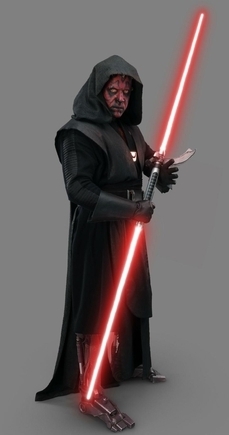
Darth Maul, also known simply as Maul, is a character in the Star Wars franchise. He first appeared in the 1999 film Star Wars: Episode I – The Phantom Menace as a powerful Sith Lord and Darth Sidious' first apprentice. Though seemingly killed by Obi-Wan Kenobi at the end of the film, Darth Maul returned in the 2008 computer animated series Star Wars: The Clone Wars. Star Wars creator George Lucas had intended for the resurrected Maul to serve as the main antagonist of the sequel film trilogy, but these plans were abandoned when Disney acquired Lucasfilm in 2012. The character nonetheless reappeared in the 2014 animated series Star Wars Rebels and the 2018 film Solo: A Star Wars Story, voiced again by Witwer; Park physically reprised the role in Solo. Since his initial defeat in The Phantom Menace, Maul has become an independent criminal mastermind and endured as Obi-Wan's archenemy.
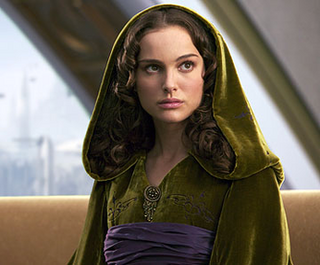
Padmé Amidala is a fictional character in the Star Wars franchise, appearing in the prequel trilogy portrayed by Natalie Portman. First indirectly mentioned in Return of the Jedi, she is introduced in The Phantom Menace as the teenage Queen of Naboo, and after her reign, becomes a senator and an anti-war activist in the Galactic Senate. She secretly marries Anakin Skywalker, a Jedi Knight, then later dies while giving birth to twins Luke Skywalker and Leia Organa. Anakin's fear of losing Padmé serves as the catalyst in driving him to the dark side of the Force and becoming Darth Vader.

The Thief and the Cobbler is an unfinished animated fantasy film co-written and directed by Richard Williams. Originally devised in the 1960s, the film was in and out of production for nearly three decades due to independent funding and ambitiously complex animation. It was finally placed into full production in 1989, when Warner Bros. agreed to finance and distribute the film. When production went over budget and behind schedule, it was heavily cut and hastily re-edited by producer Fred Calvert without Williams's involvement. It was eventually released by Allied Filmmakers in 1993 with the title The Princess and the Cobbler. Two years later, Miramax Films, which was owned by Disney at the time, released another re-edit titled Arabian Knight. Both versions of the film performed poorly at the box office and received mixed reviews.
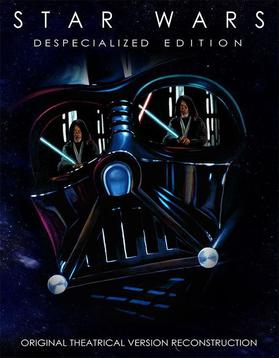
Star Wars: The Despecialized Edition, also known as Harmy's Despecialized Edition, is a fan-created film preservation of the original Star Wars trilogy films: Star Wars (1977), The Empire Strikes Back (1980) and Return of the Jedi (1983). It is a high-quality replica of the out-of-print theatrical versions, created by a team of Star Wars fans with the intention of preserving the films, culturally and historically. The project was led by Petr Harmáček, then an English teacher, from Plzeň, Czech Republic under the online alias Harmy.

Obi-Wan Kenobi is an American television series created for the streaming service Disney+. It is part of the Star Wars franchise and stars Ewan McGregor as the title character, reprising his role from the Star Wars prequel trilogy. Set ten years after the events of Star Wars: Episode III – Revenge of the Sith (2005), the series follows Kenobi as he sets out to rescue the kidnapped Princess Leia from the Galactic Empire, leading to a confrontation with his former apprentice, Darth Vader.
References
- ↑ Cook, James. "The 15 Coolest Fan Edits Of Popular Movies". Business Insider.
- ↑ "Fan editors are artists, not disgruntled fans, KU scholar argues". College of Liberal Arts & Sciences. November 6, 2014. Archived from the original on February 27, 2018. Retrieved February 27, 2018.
- ↑ the bizarre world of fan edits and restorations by Royal Ocean Film Society on Vimeo
- ↑ Kraus, Daniel (November 6, 2001). ""The Phantom Edit"". salon.com. Retrieved April 17, 2017.
- ↑ Rojas, Peter (July 24, 2002). "Hollywood: the people's cut". The Guardian. Retrieved April 18, 2017.
- 1 2 Mason, Matt (2008). The Pirate's Dilemma: How Youth Culture is Reinventing Capitalism. Free Press. p. 87.
- 1 2 Wille, Joshua (January 20, 2015). "'The Hobbit: The Tolkien Edit' and Screener-based Fan Edits". wille.tv. Archived from the original on July 27, 2021. Retrieved April 19, 2017.
- ↑ Matthew Wilhelm Kapell; John Shelton Lawrence, eds. (July 1, 2006). Finding the Force of the Star Wars Franchise: Fans, Merchandise, and Critics. Peter Lang. p. 259. ISBN 0820488089.
- ↑ "Steven Soderbergh posts his 110-minute recut of 2001: A Space Odyssey". avclub.com. January 14, 2015. Retrieved April 17, 2017.
- ↑ "Steven Soderbergh tries to fix 'the worst film of all time' with his own fan edit". theverge.com. April 28, 2014. Retrieved April 17, 2017.
- ↑ Gelderblom, Peet. "FEATURE FILM WITH VIDEO ESSAY: Brian De Palma's RAISING CAIN is re-cut - IndieWire". indiewire.com. Retrieved April 17, 2017.
- ↑ "Changing Cain: How my fan-edit became a Brian De Palma Director's Cut – DIRECTORAMA - Peet Gelderblom". directorama.net. July 26, 2016. Retrieved April 17, 2017.
- ↑ "Game Of Thrones (TV Series) - Fanedit.org - IFDB". ifdb.fanedit.org. Retrieved October 19, 2019.
- ↑ Cleanflix (2009) - Turner Classic Movies
- ↑ CLEANFLIX - Teaser Trailer on Vimeo
- ↑ "Thief and the Cobbler: The Recobbled Cut". Cartoon Brew. June 24, 2006. Retrieved May 9, 2009.
- ↑ Brown, Todd (June 4, 2006). "Richard Williams' Lost Life's Work Restored By One Obsessive Fan ..." Twitch. Retrieved May 11, 2009.
- ↑ "FLIP: Pete Western reports on "A Moment in Time" at BFI – the first ever public screening of "The Thief and the Cobbler" in the UK". flipanimation.blogspot.co.uk. June 9, 2014.
- ↑ Watch 'Breaking Bad' Edited Down to a Two-Hour Movie - Fuse
- ↑ How Two Breaking Bad Superfans Turned Their Favorite Show Into a Movie|Vanity Fair
- ↑ Breaking Bad: The Movie shows why Breaking Bad had to be 5 seasons long - Vox
- ↑ ‘Breaking Bad’ The Movie: How Condensing the Show Robs You of What You Really Want — Walt and Jesse, Together|IndieWire
- ↑ Sharf, Zack (July 7, 2022). "'Star Wars' Fan Edits 'Obi-Wan Kenobi' Into a Two-Hour Movie to Fix 'Awkward Pacing'". Variety . Retrieved August 25, 2022.
- 1 2 "Rules – Fanedit.org". fanedit.org. Archived from the original on April 19, 2017. Retrieved April 18, 2017.
- ↑ "Science Fiction News of the Week". March 25, 2009. Archived from the original on March 25, 2009. Retrieved April 17, 2017.
- ↑ ""The Clones Revealed" - Available Now! - Original Trilogy". originaltrilogy.com. Retrieved April 18, 2017.
- ↑ "Fanedit Forums". fanedit.org. Archived from the original on April 19, 2017. Retrieved April 18, 2017.
- ↑ "MPAA 'Castrates' World's Biggest FanEdit Movie Site - TorrentFreak". torrentfreak.com. November 23, 2008. Retrieved April 17, 2017.